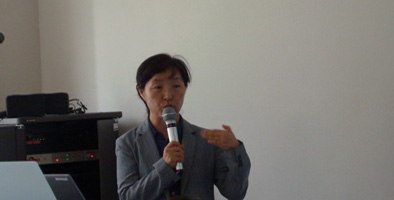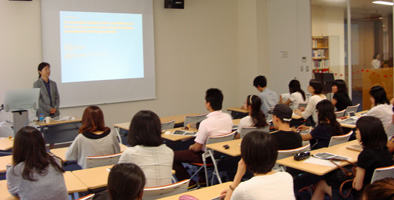- HOME
- NOTICES
- RCAPS Seminar: Dr. SON Mi Young (Assistant Professor, Korea National Open University, RCAPS Visiting Research Fellow)
Aug 1, 2012
A comparative analysis of the competitiveness of Korean and Japanese fashion industries by applying the generalized Double Diamond Model
Dr. SON Mi Young in her introduction explained that changes in consumption patterns, diverse market opportunities, globalization of production and sales, intensifying global competition, and complex trade mechanisms such as the World Trade Organization (WTO) and Free Trade Areas (FTA) continue innovation, and changes are being encouraged. Since the dramatic fashion market is situated with both global and domestic fashion brands, it is crucial for Korea’s fashion industry to participate in the global market.
According to many mainstream economists’ views, the modern fashion industry is situated to early economies and plays a key role in the initial industrialization process, because it is labor intensive but requires a low level of technology. Many East Asian countries followed in Japan’s footsteps to become major suppliers in today’s international textile and apparel market. She noted that the Korean fashion industry in terms of political, economic, societal, cultural, fashion structure, consumers’ fashion awareness, purchase, behavior, business practices, development process, and geographical proximity among other aspects, has similarities to the Japanese fashion industry.
On the Double Diamond Theory, Dr. SON Mi Young said that linking the domestic diamond of each country to that of a relevant “tried”, thus incorporating the international context of national competitiveness usually fits countries like Canada and New Zealand well, but it may not fit a smaller country like Korea or Singapore.
She concluded that it is very significant to the generalized Double Diamond Model to visualize a comparison of the Korean fashion industry, which is a small and open economy, with the Japanese fashion industry, based on advanced and high level technology.
Study on future agendas for “sustainable development” in the Korean fashion industry
Dr. SON Mi Young explained that the fashion industry and sustainable growth are in fact correlated to each other in both negative and positive ways. For a long time, many efforts have been made to improve the negative correlation between the fashion industry and sustainable growth. She explained that sustainable development is development which meets the needs of the present without compromising the ability of future generations to meet their own needs.
The Korean Ministry of Knowledge Economy and Ministry of Federation of Textile Industries are playing significant roles in the sustainable development in the fashion industry, such as restructuring the export-oriented green textile industry structure, and adopting green innovative vision and core projects for the textile and fashion industries. Low green growth results, passivity in responding to green efforts, and using the concept of sustainable development as a marketing tool for small-scale businesses to speed such effort throughout the overall industry are limitations of marketing strategy in the fashion industry.
Dr. SON in conclusion asserted that attempts should be made for fair trade and its contribution to the community to build economic trust, and human rights management and labor practices to implement social responsibility should be intensified. Also, attention should be paid to the issues of environmentally hazardous substances caused by packing wastes and to developing systems that encourage recycling.
Written by Mr AMO Thompson (APU GSAM)
RCAPS Seminar: Dr. SON Mi Young (Assistant Professor, Korea National Open University, RCAPS Visiting Research Fellow)
On July 30, 2012, Dr. SON Mi Young (Assistant Professor, Korea National Open University,
RCAPS Visiting Research Fellow) was invited to present an RCAPS Seminar entitled, "Studies on the Competitiveness and the Sustainable Development in the Korean Fashion Industry" (i) A Comparative Analysis on the Competitiveness of the Korean and Japanese Fashion Industry by Applying Generalized Double Diamond Model, (ii) Study on Core Agendas for "Sustainable Development" in the Korean Fashion Industry. Dr. Son presented two papers.

A comparative analysis of the competitiveness of Korean and Japanese fashion industries by applying the generalized Double Diamond Model
Dr. SON Mi Young in her introduction explained that changes in consumption patterns, diverse market opportunities, globalization of production and sales, intensifying global competition, and complex trade mechanisms such as the World Trade Organization (WTO) and Free Trade Areas (FTA) continue innovation, and changes are being encouraged. Since the dramatic fashion market is situated with both global and domestic fashion brands, it is crucial for Korea’s fashion industry to participate in the global market.
According to many mainstream economists’ views, the modern fashion industry is situated to early economies and plays a key role in the initial industrialization process, because it is labor intensive but requires a low level of technology. Many East Asian countries followed in Japan’s footsteps to become major suppliers in today’s international textile and apparel market. She noted that the Korean fashion industry in terms of political, economic, societal, cultural, fashion structure, consumers’ fashion awareness, purchase, behavior, business practices, development process, and geographical proximity among other aspects, has similarities to the Japanese fashion industry.
On the Double Diamond Theory, Dr. SON Mi Young said that linking the domestic diamond of each country to that of a relevant “tried”, thus incorporating the international context of national competitiveness usually fits countries like Canada and New Zealand well, but it may not fit a smaller country like Korea or Singapore.
She concluded that it is very significant to the generalized Double Diamond Model to visualize a comparison of the Korean fashion industry, which is a small and open economy, with the Japanese fashion industry, based on advanced and high level technology.
Study on future agendas for “sustainable development” in the Korean fashion industry
Dr. SON Mi Young explained that the fashion industry and sustainable growth are in fact correlated to each other in both negative and positive ways. For a long time, many efforts have been made to improve the negative correlation between the fashion industry and sustainable growth. She explained that sustainable development is development which meets the needs of the present without compromising the ability of future generations to meet their own needs.
The Korean Ministry of Knowledge Economy and Ministry of Federation of Textile Industries are playing significant roles in the sustainable development in the fashion industry, such as restructuring the export-oriented green textile industry structure, and adopting green innovative vision and core projects for the textile and fashion industries. Low green growth results, passivity in responding to green efforts, and using the concept of sustainable development as a marketing tool for small-scale businesses to speed such effort throughout the overall industry are limitations of marketing strategy in the fashion industry.
Dr. SON in conclusion asserted that attempts should be made for fair trade and its contribution to the community to build economic trust, and human rights management and labor practices to implement social responsibility should be intensified. Also, attention should be paid to the issues of environmentally hazardous substances caused by packing wastes and to developing systems that encourage recycling.
Written by Mr AMO Thompson (APU GSAM)

PowerPoint(PDF)
Video(WMV)
- TOPIC
- セミナー

